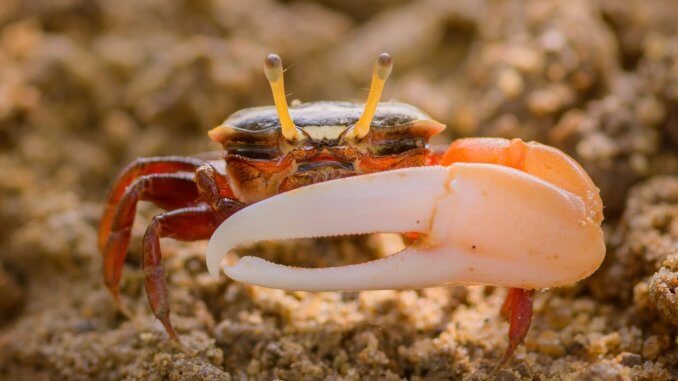
The fiddler crab is a brackish water species of crab of the Ocypodidae family. This species is related to more than 100 other species of semi-terrestrial marine crabs.
Fiddler crabs get their names from the appearance of the male crab’s claws — one distinctively large claw held like a violin or fiddle. These crabs are small, peaceful, and sociable creatures.
The fiddler crab makes an interesting addition to a fish aquarium, and this species is popular amongst beginner aquarists because it’s easy to care for and keep.
TABLE OF CONTENTS
Fiddler Crab Facts & Overview
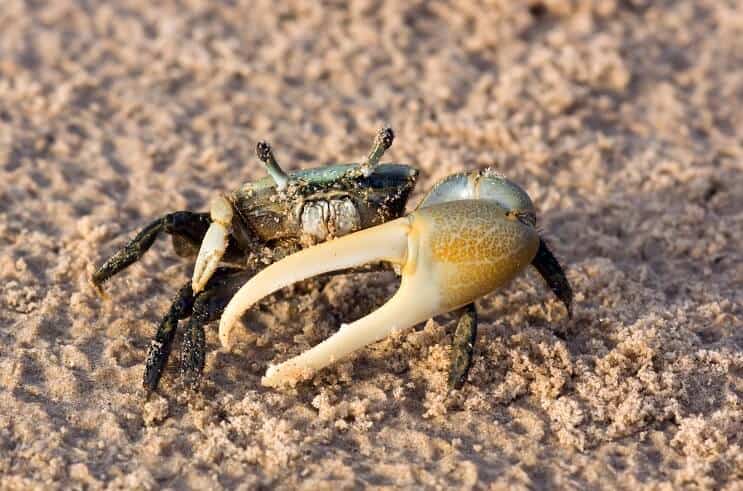
| Scientific name: | Uca spp., Ocypodidae family |
| Common names: | Fiddler crab, marsh fiddler crab, red-jointed fiddler, China-black fiddler, sand fiddler crab, marsh fiddler crab, calico fiddler |
| Distribution: | Throughout the world in the Atlantic, Eastern Pacific, and Indo-Pacific |
| Size: | 2–3 inches |
| Life expectancy: | Up to 3 years |
| Color: | Black with brownish claws |
| Diet: | Omnivore |
| Temperament: | Peaceful |
| Minimum tank size: | 10 gallons |
| Temperature: | 75–86°F (23–30°C) |
| pH: | 8.0–8.3 |
| Hardness: | 8–25 dGH |
| Care level: | Easy |
Origin
The fiddler crab is found all over the world and is prominent in mangroves, on sandy or muddy beaches, and in salt marshes in the Western Atlantic, West Africa, Indo-Pacific, Eastern Pacific, and Portugal.
These crabs are found abundantly on ocean beaches in the intertidal zone, as they have the unique ability to survive on land and submerged in water.
Adult Size & Lifespan
The full-grown adult size of a fiddler crab is 2–3 inches. Males are larger and heavier than females.
In the wild, fiddler crabs live for about two years, but they live for up to three years in captivity.
Availability
Fiddler crabs are commonly available in aquatic stores, as well as online marketplaces like eBay. The average cost of a fiddler crab is $4.50–$6.
To ensure fiddler crabs are healthy and responsibly bred, buy them from reputable online stores, including:
Appearance & Behavior
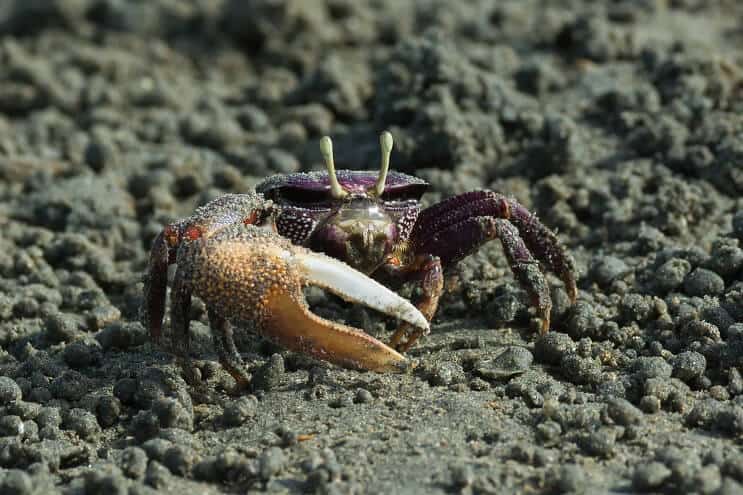
The fiddler crab has a blue, black, or brown carapace (shell). It is a sociable species that communicates with its claws.
This crab is small, friendly, and only shows aggression during the mating season.
Colors, Patterns, and Size
Fiddler crabs have square-shaped bodies and smooth carapaces — hard plates protecting the organs — in shades of brown or gray.
Males are brighter in color compared to females and have a strong purple-gray or blue tone to their shells. Females have two small feeder claws, while males have one oversized claw (growing up to 2 inches long) and one normal-sized claw.
Full-grown fiddler crabs reach between 2 and 3 inches long, and males grow bigger than females. On the front of the crab’s body are two small eyes that protrude from long, slim eyestalks, and a pair of antennae that are used to detect smells externally.
The exact color of a fiddler crab depends on the species, with colors ranging from orange-brown to blue-gray. The red-clawed fiddler crab, which has bright-red claws, is a popularly stocked color variation of the species.
In the wild, fiddler crabs change color around spring tide and low tide, when breeding activity is high. Fiddler crabs also change color as a response to stress, to regulate their internal temperature, or to match the colors of their environment.
Typical Behavior
Fiddler crabs are peaceful, sociable crabs that communicate with one another by raising and lowering their claws. The crabs are only aggressive and territorial during breeding, and the males are known to fight with their claws when they compete for the females’ attention.
Fiddler crabs are able to survive in and out of the water and have a primitive lung for breathing air, and gills for breathing underwater. The crabs are semi-terrestrial, and divide their time between exploring the substrate underwater and sitting on land.
Fiddler crabs enjoy being out in the open, but they’re known to hide when scared or molting.
The fiddler crab molts every eight weeks, shedding its old exoskeleton in place of a new one.
Fiddler Crab Tank & Water Requirements
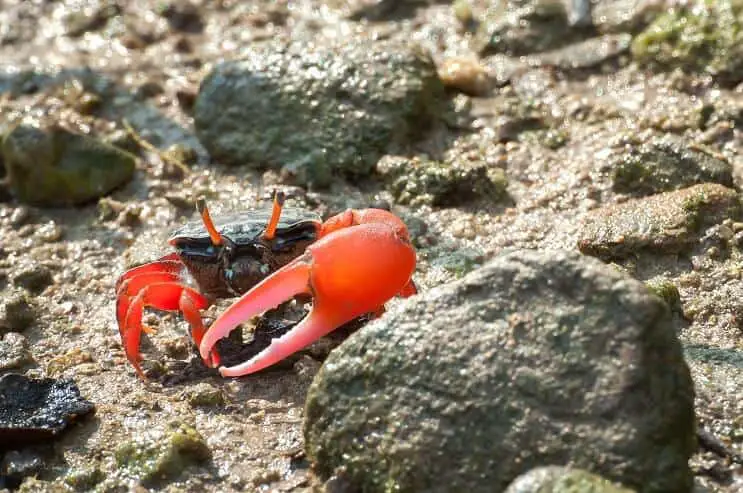
The fiddler crab tank should replicate the crab’s wild habitat as closely as possible, with brackish water, and access to underwater and above-ground habitats.
The crabs should be housed in a tank that holds at least 10 gallons of water.
Habitat and Tank Requirements
In the wild, fiddler crabs live on the coastline. Following the natural movement of the tide, the crabs spend some of their time on rocky, sandy shores, and some of their time underwater. The water in this habitat is brackish, warm, slightly alkaline, and aerated.
Replicate this environment as closely as possible to ensure your fiddler crabs are settled in the tank.
To set up a fiddler crab tank, follow these steps:
- Add a layer of soft, sandy substrate to the bottom of the tank, which the crabs can sift through to burrow and feed. The sand should be at least 3 inches deep on one side of the tank, and should slope up to provide an above-water area on the other side of the tank.
- Place large rocks, driftwood, and caves in the tank, providing shelter, resting spots, and hiding places for the crabs. Don’t add live plants because the crabs will likely destroy these.
- Fill one-fifth of the tank with low-salinity brackish water, making sure there’s enough above-water space for the crabs to sit.
- Install a water heater to maintain a warm temperature, and use an air pump to keep the tank oxygenated.
Water Conditions
The ideal tank conditions for fiddler crabs are:
| Water type: | Brackish, slightly alkaline, low-salinity |
| Tank size: | Minimum 10 gallons for one to four crabs, and an extra 3–5 gallons per additional crab |
| Water temperature: | 75–86°F |
| Substrate: | Soft sand |
| Tank setup: | Rocks, driftwood, caves |
| Acidity: | 8.0–8.3 pH |
| Water hardness: | 8–25 dGH |
| Filter: | Yes, to keep the water clean and aerated |
| Bubbler: | Yes, to oxygenate the tank |
| Lighting: | Yes, provide lighting for around 12 hours per day to represent natural daytime and nighttime |
| Water heater: | Yes, to keep the water warm |
Brackish water with a low salinity is essential in a fiddler crab tank. The crabs can’t survive in fully freshwater or saltwater environments, so the tank water should have a salinity of between 1.01 and 1.08 specific gravity.
You can achieve this salinity by adding measured amounts of high-quality marine salt to freshwater.
Care & Diet
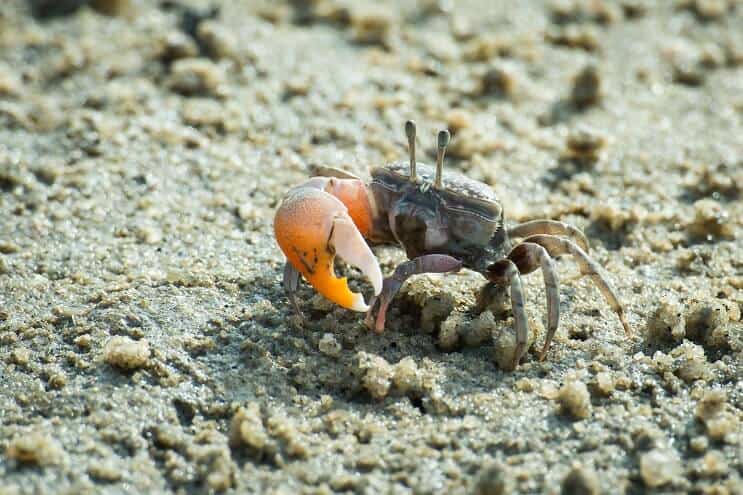
Caring for fiddler crabs is easy as long as you keep the tank clean. Feed the crabs an omnivorous diet of plants and rich protein sources, and look out for common diseases, like shell disease.
Diet and Feeding
In the wild, fiddler crabs sift through the substrate to find algae, fungus, and bacteria. Provide a variety of foods in captivity to ensure the fiddler crabs receive a nutritious diet.
Good foods to feed fiddler crabs are:
- Sinking foods like shrimp pellets
- Frozen plankton
- Frozen brine shrimp or bloodworms
- Seaweed
- Lettuce
- Zucchini
Feed fiddler crabs a pinch of food twice daily, providing a combination of nutritious plant-based and protein-based foods to prevent health issues and obesity.
They are known to eat parts of their old exoskeletons after molting. These provide a good source of calcium, so you should leave them in the tank for a week after the crabs have molted.
General Care
Caring for fiddler crabs is easy because they’re hardy and can cure themselves of many diseases by molting. To keep these crabs healthy, feed them a nutritious diet, use a good water filter, and change 20% of the water once every three weeks.
As highly-social animals, fiddler crabs should be kept in groups of at least two. They don’t need supplements as long as their food provides a complete source of nutrients.
Common Problems
Fiddler crabs aren’t typically prone to disease in captivity.
Poor living conditions increase the risk of bacterial and fungal diseases, which damage the crab’s shell and eventually lead to shell disease — the progressive degradation of the exoskeleton. Prevent shell disease by keeping the tank water clean and changing the water regularly.
Fiddler crabs are particularly vulnerable after molting because their new exoskeletons are soft and delicate. To prevent damage to the shell, avoid bothering the crab and allow the crab to stay isolated until it becomes active again.
Is a Fiddler Crab Dangerous?
Fiddler crabs aren’t dangerous to handle, but they are delicate. The crabs prefer not to be touched and are known to pinch people when they feel threatened, so don’t buy a fiddler crab if you want a pet that you can handle.
Tank Mates
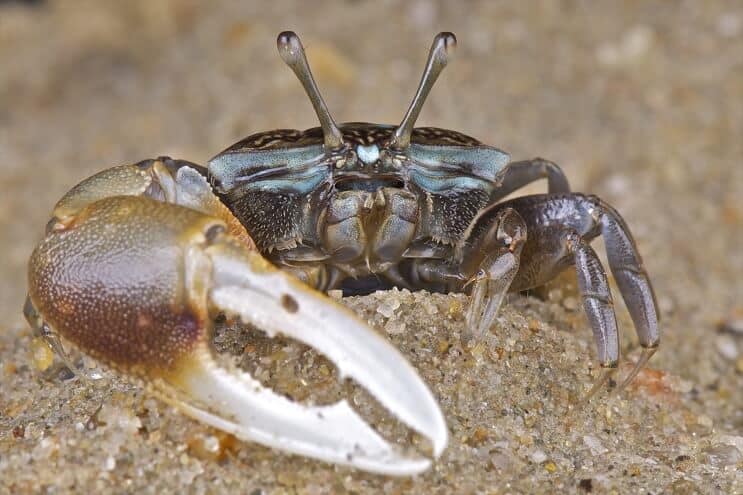
Because of their specific water requirements and their need for a sloping substrate, fiddler crabs are usually housed alone, or in groups of their own kind. Not many fish can survive in the low-salinity water that fiddler crabs need, and the crabs are known to attack fish with their claws.
Possible tank mates for fiddler crabs are:
If you plan to add fish to your fiddler crab tank, make sure there’s plenty of water for the fish to swim in.
Non-fish tank mates for fiddler crabs are:
Breeding
Breeding fiddler crabs in captivity isn’t possible because the fiddler crab’s larvae need to be carried in the ocean’s water column during their development. This can’t be recreated in captivity, so the larvae are unable to develop properly in an aquarium.
Fiddler crabs still attempt to spawn in captivity, and the males court the females by building sand hoods and waving their large claws. In some cases, the female will lay eggs, but the larvae won’t develop.
Should You Get a Fiddler Crab for Your Aquarium?
Fiddler crabs are hardy, unique-looking crabs that are easy to look after. You should buy fiddler crabs if you plan to set up a dedicated tank with the right water conditions for this species.
Don’t buy fiddler crabs if you want to add the crabs to a pre-existing tank that doesn’t suit their requirements. If you plan to house fiddler crabs and fish together, make sure there’s plenty of room for the species to cohabitate.
Despite their incompatibility with most fish and their specific requirements for brackish water, fiddler crabs are entertaining creatures that are ideal for people looking for a change from fishkeeping.

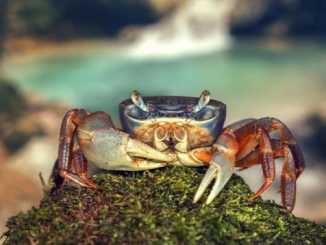
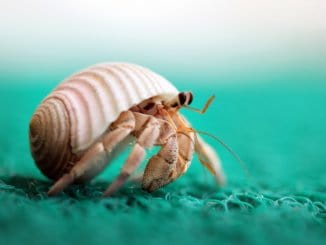
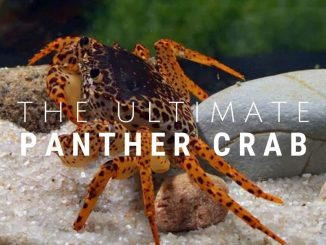

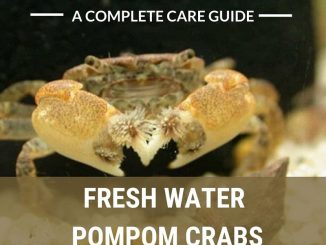
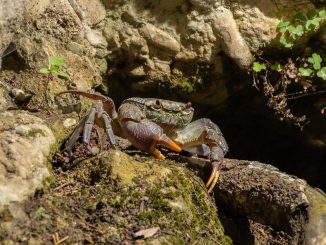
Yes, Its here!
But does anyone know the most common species of Fiddler Crab used for the pet trade?
We bought a male and female fiddler crabs about a year ago. We have never added salt and our crabs are doing great. They are very active and have grown significantly since we purchased them. They are in a 10 gallon tank. We have a large log that allows them to get out of the water. Other than that we haven’t provided any special care. We have 3 Gourmies, a couple of ghost shrimp and an algae eater. Just FYI. Everyone has been happily living in their community for about a year now.
Thank you for your comment. I just added fiddle crab to my Glow fish tank and the pet store never mentioned that they needed “blackwater” or air! Now I’m going to the pet store to get the tank set up properly.
I would love to know what pet store you purchased yours from. I got two and both of mine ended up dying within a week. And after reading the forum it seems salt is the only thing I didn’t do. So unless I just bought them from a poor supplier I am really unsure what went wrong.
This is good information to care for fiddler crabs but I just wanted to note the salinity range or specific gravity of the water. I think there might just have been a typo but I am assuming the writer meant 1.001 to 1.008 range. Anything above 1.01 or 1.015 might not be too beneficial for fiddler crabs. Overall, the article helped me and was really informative.
I’m shocked at the amount of irresponsible owners in the comments. These crabs require brackish water. That’s great that yours didn’t die but as other comments obviously proof, they need it to survive so if you’re not going to do one of the basic necessities for a certain species and what they need to survive, don’t get it. Point blank.
I see multiple people in here just completely shrugging away the fact that they need to have salt mixed into their water. Not tablesalt either.
I bought a fiddler crab at Petco 4 months ago. He’s been in a 29 gal. Freshwater tank. I read up on him and immediately got him a 10 gal tank, sand sea salt and the food he requires. I feel awful I didn’t do my research before hand. Never again will I allow this to happen! I’m pretty sure his tank is ready to go. Thanks for the info on these crabs. Petco should know better also!
I’ve got a heavily (fake) planted 10 gallon, nice sandy bottom rocks, driftwood, and a big, holey lava rock to climb and hide in.
In it I have a pair (M/F), some amano shrimp, snails, and 2 female guppies (they’re the only survivors of a small school I put in there).
I recently got some Endler’s live-bearers from Josh’s Frogs in Owosso, MI who have recently bred. If I have too many males among the fry, I plan on acclimating them to the brackish water and seeing if I can keep some brackish Endler’s guppies.
I recently purchased fiddler crabs, the pet store I got them from had them in a large, completely underwater, freshwater tank. I put them in my freshwater tank, but after reading this article I put them in a separate tank with sand, brackish water, and lots of hides. I just wish that more pet stores would take better care of their crabs and tell customers how to properly look after them.
How can I create a brackish water with household item or an alternate. Is Aquarium salt good enough